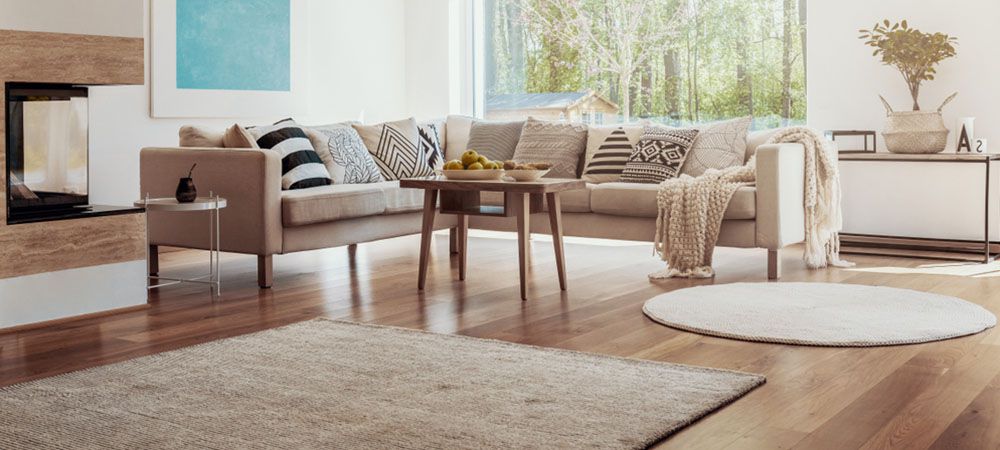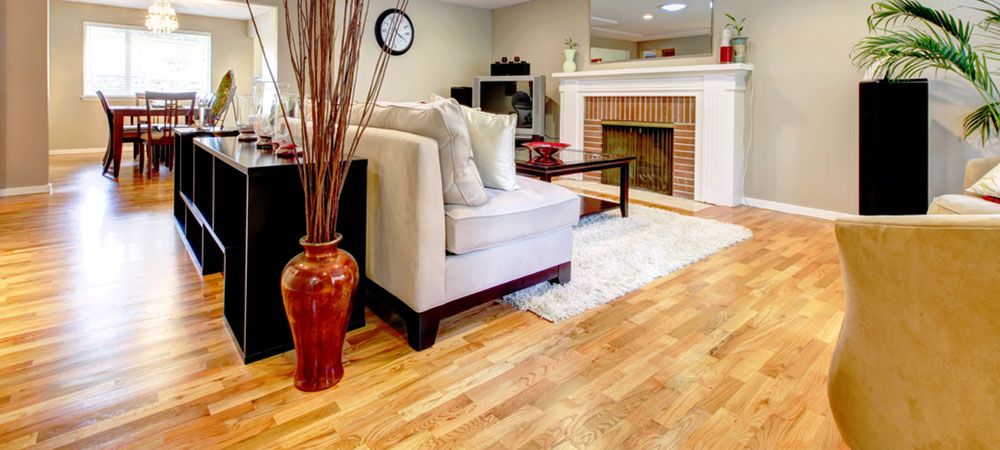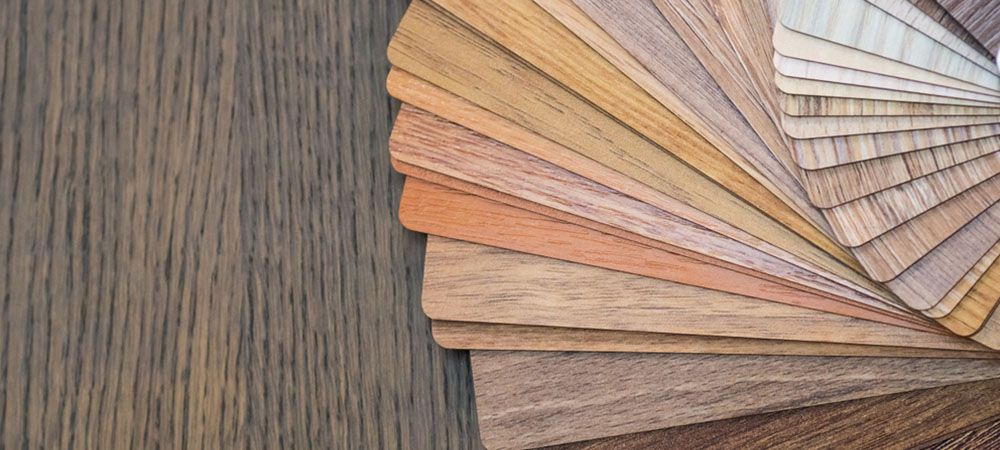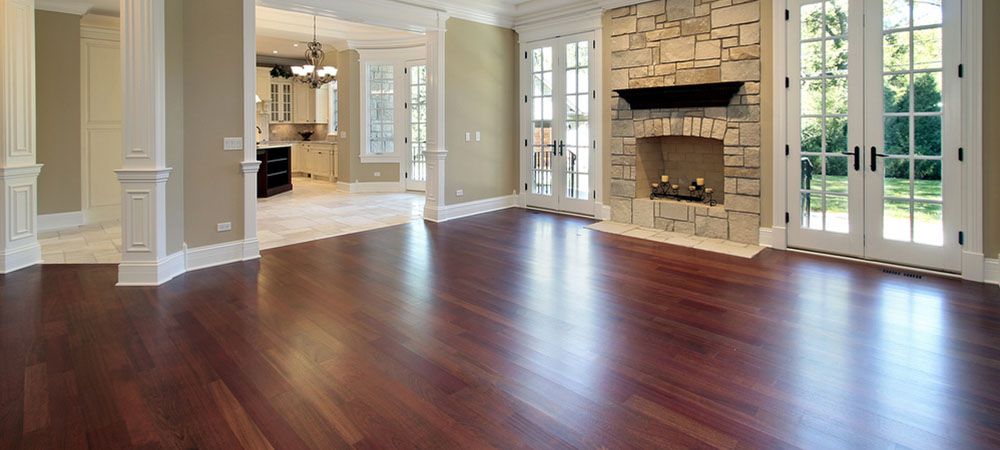You’re looking to install new flooring in your home and have finally decided to go with hardwood. First off, congratulations. You have made an excellent choice. But now comes the million-dollar question ‘Should you match your hardwood floors throughout the house?’ The good news is we understand your dilemma, and we’ll help you find answers.
Many new homeowners and renovators are usually at crossroads when it comes to choosing hardwood floors. Indeed, hardwood offers an excellent range of types, designs, and colours that can add an exciting dynamic to your home. While this means that each person can usually find their unique style of hardwood flooring, it also gives rise to more questions.
Is it better to use the same hardwood floors in every room in the house? Is it more stylish to mix the blends of hardwood floors? Are there rules for combining hardwood flooring? These are common questions many homeowners usually have running laps in their minds.
If you’re one of the numbers, don’t beat yourself up. Your curiosity is perfectly understandable, necessary even. After all, the flooring in your home is one of the most significant financial investments you will make.
Moreover, hardwood flooring is not something you can easily remove and take back to the store if you don’t like it. Therefore, it is best to carry out adequate research before you take action.
If you’re wondering whether or not you should match your hardwood floors throughout the house, you’re in the right place. This article will attempt to clear the air on the same or different hardwood floor debate.
Also, we will give you some tips on how to use hardwood flooring in your home. But first, let us examine the advantages of these beautiful floors.
Choosing Hardwood Flooring: The Benefits You Should Know
Today, an increasing number of homeowners are opting for hardwood floors in their house, and for good reasons too. Several factors make hardwood flooring a perfect choice for any room in your house.
Such reasons range from aesthetics to practicality of use and more. Keep reading to find out the top benefits of using hardwood floors in your home.
It is easy to maintain

One of the most popular benefits of hardwood flooring is its ease of maintenance. Unlike other alternatives, a broom or vacuum and a mop can handle just about anything that drops on a hardwood floor.
Moreover, if you want an added shine, a regular floor polish or hardwood shine will do the trick. But this is not even compulsory.
With hardwood, vacuuming once a day is enough to keep the dust and dirt under control. However, even if you cannot clean as often as you want, hardwood’s pattern makes dirt harder to spot.
On the other hand, any spill on a carpet will likely result in a stain. In this case, you may need a combination of cleaning products and scrubbing time to get it clean again.
Related article: Benefits of Engineered Hardwood Flooring
It is extremely durable
Another feature of the hardwood floor, which makes it a popular choice is its durability. A good quality hardwood flooring will stay in good condition for decades. Indeed, with proper care, it can last a lifetime.
This particular characteristic makes hardwood flooring an ideal choice for homeowners with children and even pets. As you well know, children and pets are hard to stop when they start playing.
Of course, this is not to say hardwood floors cannot suffer mishap now and then. Perhaps a scratch here or a bang there. But there are straightforward fixes for those – a simple dab with polyurethane coating will leave your floor looking as good as new.
Indeed, if you plan to leave your home to children without wanting them having to uproot the entire floor, hardwood is the way to go.
It offers an aesthetic variety

Hardwood is undoubtedly a great way to infuse classy elegance into your home. More importantly, it does this without clashing with the remaining décor in your home. In other words, it is not difficult to match hardwood floors with ambience throughout the house. This is quite unlike carpets, linoleum, and other alternatives.
Besides, hardwood floors offer a wide range of design options – from colours and styles to stains and species. Furthermore, you can opt between pre-finished and unfinished hardwood floors. This makes it so much easier to blend hardwood flooring with your home’s design and décor.
It increases the value of your home
Do you plan to sell your home in the nearest future? Hardwood flooring can go a long way in ensuring you get a fair price. Yes, hardwood floors are long-term investments that can become a convincing resale argument when you need it. Since hardwood floors are incredibly durable and require little maintenance, buyers generally prefer it.
In other words, they are more likely to pay more for a house with hardwood flooring than one with carpets. More often not, buyers look at carpets as something they’ll have to change before moving into the home.
This is especially true if the carpets bear stains of the long years of living, as is very likely. On the other hand, hardwood floors ensure faster sales at higher prices.
It preserves your indoor air quality
Carpet fibres can trap pet hair, dust, mites, and a long list of other contaminants. While these do not sound dangerous, if you or your loved ones suffer from allergies, they can quickly become a problem. As you walk on them, you inadvertently stir up these contaminants, thereby sending up into the air you breathe.
Furthermore, the embossing and grout lines between tiles and linoleum can trap dirt and other debris. Even if nobody has asthma or other respiratory conditions, such air is not healthy for you and your family.
On the flip side, hardwood floors do not retain as must dust and dirt. As a result, you’d enjoy cleaner air, which is less likely to trigger allergies or respiratory issues.
It is a greener option
If you want to own a beautiful home but not at the expense of the environment, hardwood flooring is the way to go. You see, hardwood is all-natural and comes from trees, which are a renewable resource.
Furthermore, if the time comes when you need to change your floor (if you ever need to), hardwood floors decompose to nourish the earth. However, we cannot say the same of other flooring alternatives.
Now that you know the various advantages that make hardwood flooring your best bet let us see you can install it right. In the next few paragraphs, we’ll help you find answers to whether or not your hardwood floors should match throughout the house. This way, you not only buy an excellent floor option, but you use it in the best possible way.
Should Hardwood Flooring Match Throughout Your House?

Over the years, there has been an ongoing controversy about whether homeowners should match hardwood floors in every room in the house or not. While there is no right or wrong answer to this debate, one thing is apparent.
Mixing different types of hardwood floors throughout your home can help you achieve a rather stunning effect. The key is to blend the hardwood floors the right way.
On the other hand, many argue that using the same hardwood floor in every room in the house will ensure a better sense of uniformity and space. However, combining different shades or styles of hardwood does not need to result in a haphazard finish. All you need is the right tips on design considerations for hardwood floors, and you’re good to go.
Moreover, when you buy our hardwood floors in Canada, you secure a world of knowledge and advice from our experts. This way, you can proceed safely in the knowledge that seasoned professionals are guiding your flooring decisions.
Most people draw their home décor decorations from popular trends. Therefore, it is no wonder there is an ongoing debate about using the same hardwood floor or mixing the options. Many are firm in the opinion that hardwood floors should match throughout the house. On the other hand, some people swear by mixing your hardwood flooring combinations.
In the spirit of transparency, both decisions can result in a beautiful and classy finish. But, there are different design considerations for hardwood floors that you must bear in mind. We’ll get into this guide later on in this article. But first, let us look at some of the advantages of using hardwood floors that match throughout the house. We will also examine some upsides to being adventurous with your hardwood floor choices.
Advantages of Using Matching Hardwood Flooring in Your Home
Let us first explore what you get when you match hardwood floors throughout the house.
- It ensures a natural flooring flow through your house. The most obvious advantage of using matching hardwood floors in every room in the house is the uniformity you achieve. It can also have a soothing effect due to the natural flow of things.
- It boosts the illusion of a bigger space. If your home is a tad smaller than you’d like, then using the hardwood floors that match throughout the house can make it look bigger. This is because it creates a consistency that tricks the eye into thinking the home is more spacious than it really is.
- It makes the interior design more straightforward. Many of the people who match their hardwood floors believe that it makes interior design easier. In other words, they don’t have to worry about choosing a décor or theme for every room. One shoe fits them all.
- It speeds up the installation process. After you buy your hardwood floor in Canada, you’ll need to install it. Using the same type, colour and pattern of hardwood can make the installation much smoother and faster. You can eliminate delays from wondering what goes where and find the right tone to coordinate with the rest.
- It is more cost-effective. Lastly, people on this side of the debate will argue that you should use hardwood floors that match every room in the house to save some money. You see, using the same floor allows you to buy all the hardwood you’ll need in bulk. As a result, you can cut back on some expenses.
That said, let us take to the other side of this argument and look at things from their perspective. Indeed, both sides have equally compelling arguments. So, it is worth the time and effort to examine the hardwood flooring controversy from both angles.

The Advantages of Mixing Different Hardwood Floors in Your Home
For many, the thought of using complementary shades and designs of hardwood feels them with so much excitement. As such, let us examine some benefits of being creative with the blend of hardwood floors in your home.
- It helps to make each room unique. If you are looking to stamp various personalities on your home’s space, then mixing up the hardwood floor is a great way to do it. For instance, darker colour wood can give your study a look of antiquity.
- It can help divide your home into zones. Mixing hardwood floor designs can help you demarcate the layout of your house. Depending on the colours you use, visitors will have no problem distinguishing between your reception space and living areas.
- It can help to support the aesthetic qualities of each room. If you want to be creative with your home décor, using hardwood flooring that matches your design will pass a much stronger message. You can also set the tone and ambience for each room.
- It aids practicality. The hardwood flooring you want for the rest of your home may not be ideal for places like the kitchen. As a rule of thumb, a tough and easy-maintenance wood should go into your kitchen due to the nature of activities there. By mixing the choice of hardwood floors in your home, you have the freedom to install more practical options in specific places.
At the end of the day, the decision of whether or not to match hardwood floors throughout the house boils down to you. Therefore, you should base your choice on your preference and individual style. That said, let us show you how to use mixed hardwood flooring in your home without setting off the interior design police.
Design Considerations for Hardwood Floors: How to Make the Right Decision
Generally, using hardwood flooring can give your home a stunning and luxurious look. However, there are several things you need to consider before you make your flooring decisions.
This is especially true if you are combining different grains and colours. In the next few paragraphs, we will give you some tips on how to use hardwood floors, irrespective of whether or not you match them.
Choose hardwood grains based on the size and location of the room
Are your rooms facing the south? Are they large? If your answer on both counts is a yes, using a dark tone of hardwood flooring can add an elegant feel to the room.
Possible options include mahogany and Brazilian walnut, amongst others. In the same vein, lighter grains of hardwood usually look better in smaller spaces. Here, you may use maple hardwood floors, white oak, or similar options.
Furthermore, irrespective of the type of hardwood you use in a hallway, your installation method can impact the perceived size. If you don’t want your hallway to appear narrow, installing the flooring parallel to the wall is not advisable. Instead, place the wood in the other direction. Little choices like this can make a significant difference after installation.
Read the room
Next on how to use hardwood flooring — reading the room. Some specific rooms in the home naturally beckon for a different type of hardwood flooring.
For instance, a darker shade of hardwood floor combined with subtle lights can lend more intimacy to a bedroom. On the flip side, using lighter tones of wood can bring life to a child’s room and make it more appealing.
On this note, it is not compulsory to match the same hardwood floor throughout the entire house. The trick is to visualize the message you want each room to pass. Think about the mood you’re trying to achieve with each room.
Once you have your answers, combine it with recommended choices from experts. Then, you can find a midpoint (if you have to) and take it from there.
Be mindful of where you switch flooring

If you don’t plan to match your hardwood floors throughout the house, this point is for you. For best results with mixed hardwood flooring, you must take notes on recommended places to switch floor types. More importantly, you must know where not to change them. That said, avoid switching up your hardwood flooring in the middle of an open area.
Indeed, it is a rookie mistake to have multiple types of flooring in one room. Instead, aim to change hardwood floors at natural boundaries between rooms. For instance, if there is a divide between your kitchen and your dining room, that is a prime transitioning area.
The use of natural dividers as switch points ensures a smooth transition between floors. Otherwise, it may look abrupt and chaotic.
Be careful with your colour choices
Whether you want your hardwood floor to match throughout the house or not, the colour remains a critical factor. However, it is especially important when mixing hardwood floors.
To create a sense of continuity. As you blend from one hardwood floor to the other, you must pay attention to colours. While there is no wrong colour, some may not look so good next to the other.
There is a simple trick to avoid colour clashes. You can use similar shades of colours to complement each other. Whatever you do, don’t place contrasting colours against one another.
Otherwise, one colour may try to outshine the other. Instead, it may be best to keep it simple and similar. This way, you can achieve a smooth flow from floor to floor inside your home.
Stick with fewer than three
Here’s another point for our multiple hardwood floors enthusiasts – keep it fewer than three. We are not saying you cannot have more than three different hardwood floors throughout your house.
No, we are saying at any point where floors meet, don’t go beyond two types. Otherwise, your interior décor can become chaotic pretty fast.
Imagine a space where your living room, dining and hallway meet and each of these areas have their unique flooring. The result will be a busy, cluttered space that is challenging to appreciate all at once.
Invariably, there will be spaces where multiple floors meet. In cases like this, we recommend you choose any two hardwood floors you like and proceed.
Think beyond the flooring
All in all, your home décor goes beyond design considerations for hardwood floors. You still need to consider the colours of the walls, your furniture, cabinets and whatnot.
All these are factors that remain relevant whether or not you match hardwood floors throughout the house. Therefore, when picking the type and colour of your hardwood flooring, keep in mind the rest of the house.
This will guide you to pick the shades and textures of hardwood floors that contribute positively to the bigger picture. This way, your entire house will be more aesthetically appealing, matching floors or not.
In case you are wondering if the furniture needs to match the hardwood floors in every room in the house, the answer is no. Instead, seek to complement, and you’d have yourself a stunning result.
Wrapping It All Up
The remains, only you have the final answer to the ‘should hardwood floors match in every room in the house’ question. It is entirely a matter of your style and preferences. We’ve only tried to show you the pros and cons of each decision you make.
However, irrespective of whether your hardwood floors match throughout the house or not, your home can still look elegant. All you need is good quality hardwood floors, the right inspiration and our top-of-the-line installation services.
Are you looking to install hardwood floors in your home? Our online store at LV Flooring offers an impressive variety of hardwood floors for you in Canada. Reach out to us today or call +14166655645 to take the first step to a luxurious hardwood floored home.
Related article: Ways to Remove Stains From Hardwood Flooring


